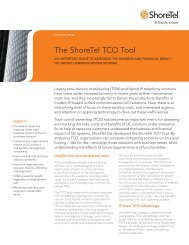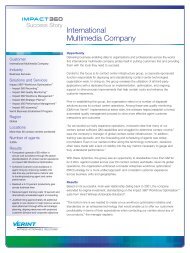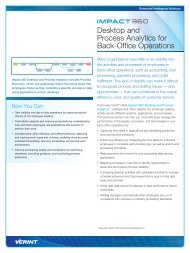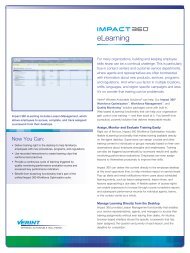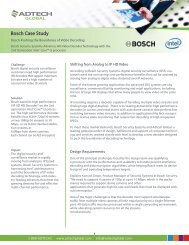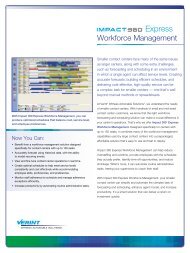ShoreTel: How UC Pays for Itself - Windstream Communications
ShoreTel: How UC Pays for Itself - Windstream Communications
ShoreTel: How UC Pays for Itself - Windstream Communications
Create successful ePaper yourself
Turn your PDF publications into a flip-book with our unique Google optimized e-Paper software.
9. Implementation planning<strong>UC</strong> supports different types of use cases, and a variety of different avenues to costjustification. Similarly, there are also a variety of ways that <strong>UC</strong> solutions can be deployed.• .In some cases, companies purchase <strong>UC</strong> functionality and roll it out broadly to all staff.Typically this approach focuses on <strong>UC</strong>-U opportunities.• .In others, the company will look <strong>for</strong> specific opportunities <strong>for</strong> <strong>UC</strong> functionality toimprove selected business processes or workflows (<strong>UC</strong>-B). This method can requireadditional upfront planning but typically provides substantially greater benefits.• Finally, there are techniques to deploy <strong>UC</strong>-U first and then incorporate <strong>UC</strong>-Bopportunities in the future.The goal of a <strong>UC</strong>-U deployment is to enable all staff to gain personal productivitybenefits. Quite frequently we find that this approach accompanies the replacement ofa legacy PBX environment with a new IP PBX solution. In many cases, the fundamentaldriver was to replace the PBX, and <strong>UC</strong> enhancements are viewed as an added benefit.<strong>UC</strong>-U deployments are often led by the IT or telecom departments with relatively littleinvolvement from business managers.In a <strong>UC</strong>-B deployment, the approach is different. Here, the goal is to identify specificbusiness processes in which communications bottlenecks or barriers exist. This meansthat the IT staff often have to work with someone from business management oroperations who can help identify appropriate opportunities. IT understands the systemcapabilities; the business manager understands where the best opportunities exist.One effective technique is to review company workflows and processes and look <strong>for</strong>areas where inadequate communications cause errors, delays, or rework. This is, ofcourse, similar to the use of lean six sigma techniques:• Start with an overview of the company’s processes• .Zero in on those that have high value or high volume and where communicationchallenges impede the process• Determine which of these “hot spots” can be mitigated by applying <strong>UC</strong> capabilities• Translate these opportunities into use cases <strong>for</strong> how processes will work and thebenefits available• Organize and prioritize opportunities to create a roadmap of <strong>UC</strong> projects• Design an action plan <strong>for</strong> implementation<strong>How</strong> Unified <strong>Communications</strong> <strong>Pays</strong> For <strong>Itself</strong>! PAGE 10






